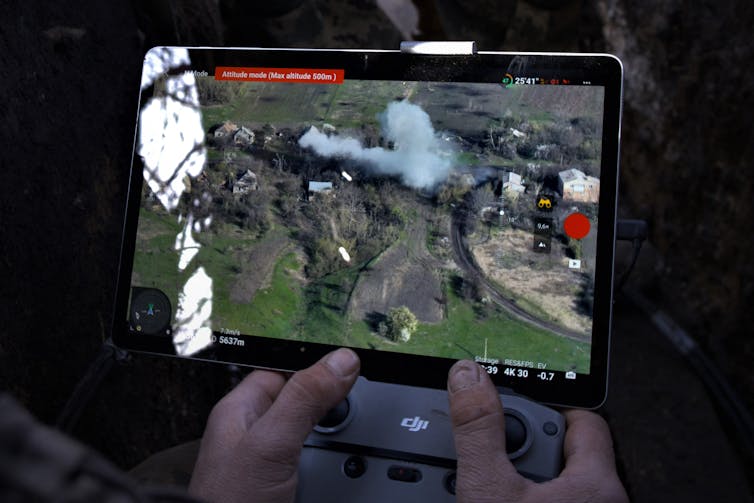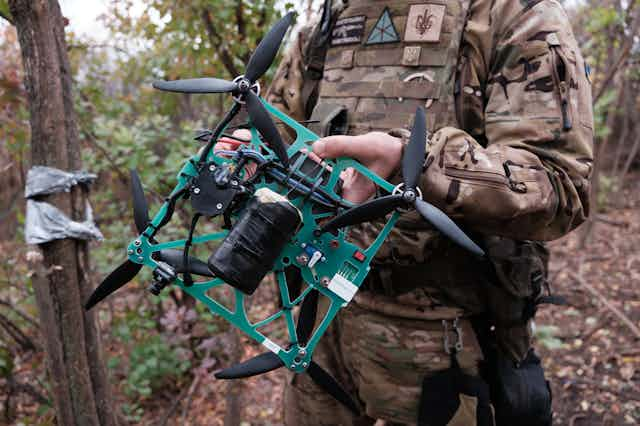Unmanned aerial vehicles, or drones, have been central to the war in Ukraine. Some analysts claim that drones have reshaped war, yielding not just tactical-level effects, but shaping operational and strategic outcomes as well.
It’s important to distinguish between these different levels of war. The tactical level of war refers to battlefield actions, such as patrols or raids. The operational level of war characterizes a military’s synchronization of tactical actions to achieve broader military objectives, such as destroying components of an adversary’s army. The strategic level of war relates to the way these military objectives combine to secure political aims, especially ending a war.
In the war in Ukraine, what have drones accomplished at these three levels?
Mounting evidence, including my own research as a military scholar who studies drone warfare, suggests that drones have delivered some tactical and operational successes for both Ukraine and Russia. Yet they are strategically ineffective. Despite its increasing use of drones, Ukraine has not dislodged Russia from the Donbas region, and Russia has not broken Ukraine’s will to resist.
Drone warfare in Ukraine
The drone war in Ukraine is evolving in ways that differ from how other countries, especially the United States, use UAVs.
First, the U.S. uses drones globally, and often in conflict zones that are not recognized by the United Nations or do not have U.S. troops on the ground. Unlike this pattern of “over-the-horizon” strikes, Ukraine and Russia use drones during an internationally recognized conflict that is bounded by their borders.
Second, the U.S. operates armed and networked drones, such as the Reaper, the world’s most advanced drone. Ukraine and Russia have adopted a broader scope of low- and mid-tier drones.
Ukraine’s “army of drones” consists of cheaper and easily weaponized drones, such as the Chinese-manufactured DJI. Ukraine has also operated Turkish-manufactured TB-2 Bayraktar drones – the “Toyota Corolla” of drones. U.K.-based defense and security think tank Royal United Services Institute estimated that Ukraine loses 10,000 drones monthly and within a year will have more drones than soldiers, implying it will acquire over 2 million drones. To manage these capabilities, Ukraine recently established a new branch of the armed forces: the Unmanned Systems Forces.

Russia has responded by importing Iranian-manufactured Shahed-136 attack drones. It has also expanded the domestic production of drones, such as the Orion-10, used for surveillance, and the Lancet, used for attacks. Russia intends by 2025 to manufacture at least 6,000 drones modeled after the Shahed-136 at a new factory that spans 14 football fields, or nearly a mile. This is on top of the 100,000 low-tier drones that Russia procures monthly.
Third, the U.S. uses drones to strike what it designates as high-value targets, including senior-level personnel in terrorist organizations. Ukraine and Russia use their drones for a broader set of tactical, operational and strategic purposes. Analysts often conflate these three levels of war to justify their claims that drones are reshaping conflict, but the levels are distinct.
Tactical effects
Drones have had the biggest impact at the tactical level of war, which characterizes battles between Ukrainian and Russian forces.
Famously, Ukraine’s Aerorozvidka Air Reconnaissance Unit used drones to interdict and block a massive Russian convoy traveling from Chernobyl to Kyiv a month after Russia’s Feb. 24, 2022 invasion of Ukraine. It did so by destroying slow-moving vehicles that stretched nearly 50 miles, causing Russia to abandon its advance.
Both militaries have also adopted low-tier “first-person-view” drones, such as the U.S.-manufactured Switchblade or Russia’s Lancet, to attack tanks, armored personnel carriers and soldiers. Russian and Ukrainian forces are increasingly using these first-person–view drones, combined with other low-tier drones used for reconnaissance and targeting, to suppress opposing forces. Suppression – temporarily preventing an opposing force or weapon from carrying out its mission – is a role normally reserved for artillery. For example, suppressive fire can force ground troops to shelter in trenches or bunkers and prevent them from advancing across open ground.
These gains have led Russia and Ukraine to develop ways of countering each other’s drones. For example, Russia has capitalized on its advanced electronic warfare capabilities to effectively jam the digital link between Ukrainian operators and their drones. It also spoofs this link by creating a false signal that disorients Ukrainian drones, causing them to crash.
As a result, Ukrainian drone operators are experimenting with ways to overcome jamming and spoofing. This includes going “back to the future” by adopting terrain-based navigation, though this is less reliable than satellite-based navigation.
Operational limitations
Drones have been less successful at the operational level of war, which is designed to integrate battles into campaigns that achieve broader military objectives.
In spring 2022, Ukraine used a TB-2, along with other capabilities, to sink Russia’s flagship ship — the Moskva — in the Black Sea. Since then, Ukrainian officials claim to have destroyed 15 additional Russian ships, as well as damaged 12 more.
Ukraine also used sea drones – uncrewed water vessels – to damage the Kerch Bridge, connecting Crimea to mainland Russia, as well as attack fuel depots in the Baltic Sea and near St. Petersburg.
Though impressive, these and other operations have momentarily disrupted Russia’s use of the Black Sea to blockade Ukraine’s grain shipments, launch missiles against Ukraine and resupply its soldiers.
The problem is that Ukraine lacks air superiority, which has encouraged its use of an army of drones to execute missions typically reserved for bombers, jets, attack helicopters and high-end drones.
Though Denmark and the Netherlands have promised to provide Ukraine with F-16 fighter jets, thus replacing the country’s aging aircraft, they have not arrived. My research also suggests that the U.S. will likely not sell its advanced Reaper drones to Ukraine, fearing crisis escalation with Russia. Further, these drones are vulnerable to Russia’s integrated air defenses.
Lack of air superiority exacerbates tactical challenges such as jamming and spoofing, while undermining Ukraine’s ability to deny freedom of maneuver to Russia.
Strategic myths
Despite these tactical effects and limited operational gains, drones are strategically ineffective.
Drones have not, and are not likely to, shape the outcome of the war in Ukraine. They have not allowed Ukraine to break its stalemate with Russia, nor have they encouraged Russia to end its occupation of Ukraine.
To the extent drones have been strategically consequential, the implications have been psychological.
Russia and Ukraine use drones to terrorize each other’s citizens as well as generate propaganda to stiffen their own citizens’ resolve. Russian and Ukrainian leaders also perceive drones as providing advantages, encouraging them to invest in these capabilities and perpetuate what I call the cult of the drone.
The lesson from Ukraine is that while drones have some value at the tactical and operational levels of war, they are strategically inconsequential. They are not a magic bullet, offering a game-changing capability to decide the fate of nations.
Instead, countries must rely on time-tested combined arms maneuver, wherein they integrate personnel and weapons systems at a particular time and place to achieve a particular goal against an adversary. When these effects are aggregated over the course of a war, they expose vulnerabilities that militaries exploit, and often with the assistance of allies and partners.
Only then can countries achieve military objectives that secure political outcomes, such as a negotiated settlement.

